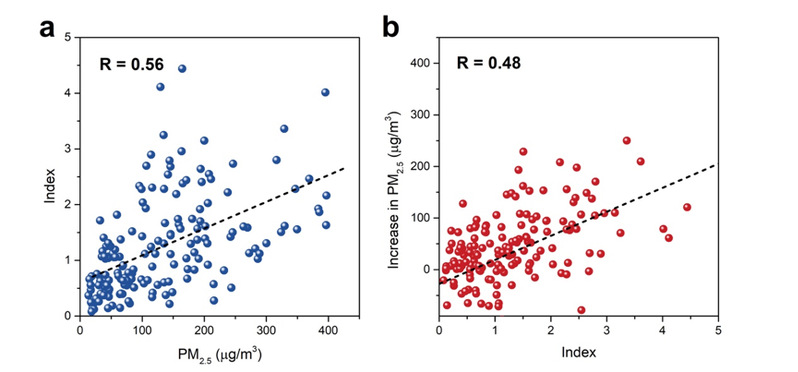Recently, Professor Aijun Ding's research group, from School of Atmospheric Sciences in Nanjing University, has made new progress in the aerosol-planetary boundary layer (PBL) interaction study. Titled 'Impact of Aerosol-PBL Interaction on Haze Pollution: Multiyear Observational Evidence in North China', the results were published on the famous journal of the American Geophysical Union (AGU), Geophysical Research Letters, with Associate Professor Xin Huang as the first author and Professor Aijun Ding the corresponding author of the paper.
Atmospheric aerosols influence the development of PBL through their radiative effect, which leads to two-way feedback between air pollution and PBL. Previous research co-conducted by Professor Aijun Ding and Associate Professor Xin Huang has shown that black carbon (BC) aerosols play a key role in this process, significantly aggravating PM2.5 in megacities, which was defined as the dome effect of BC aerosols. Relevant result was published in 2016 on Geophysical Research Letters, a research bulletin of the AGU, and was immediately greeted with great international repercussions. Such achievement has been reported by ScienceNews, a biweekly magazine with scientific news in the United States, and it has become ESI highly cited and hot paper. Under the guidance of Professor Aijun Ding and Associate Professor Xin Huang, Zilin Wang, a graduate of 2017, carried out a follow-up study on this subject. Based on WRF-Chem single-column model (SCM), she quantitatively analyzed the key factors influencing the dome effect of BC aerosols (including the height and concentration of BC aerosol layer, mixing with scattering aerosols and underlying land surface), and published the relevant result on AtmosphericChemistry and Physics, a well-known journal of the European Geophysical Union.
On the basis of previous work, the research group carried out long-term analysis and research in North China. By combining atmospheric sounding observations, global meteorological reanalysis data and ground based air quality monitoring data over the years 2010-2016, they have successfully obtained the climatological observational evidences of aerosol-PBL interaction, defining an index to quantify the impact of it. By comparing radiosonde observation with reanalysis data, they found a significant heating in upper PBL with maximum temperature change about 0.7℃ on average and a substantial dimming near surface with a mean temperature drop of -2.2℃ under polluted condition. The upper-PBL heating and surface dimming, in both spatial distribution and temporal change, is highly correlated with the aerosol concentration. In this study, the research group aims at the generation and elimination process of typical pollutions, integrates Eulerian forward simulation and Lagrangian backward trajectory calculation, and further clarifies the key role of BC aerosols and their supply in the formation and aggravation of haze. In addition, based on the radiosonde observations and reanalysis data, an index representing the overall effects on upper-PBL heating and surface dimming (so-called HD-index) was proposed, which implies the intensity of aerosol-PBL interaction. It is concluded that during heavy haze the index not only has a good correlation with the surface aerosol concentration, but also can better characterize the impact of aerosol-PBL interaction on the accumulation of multi-day pollution.
This work was supported by the Ministry of Science and Technology of the People's Republic of China (2016YFC0200500), the National Natural Science Foundation of China (91544231, 41725020, 91744311, 41422504, and 41505109), The National Science Fund for Distinguished Young Scholars, and Jiangsu Collaborative Innovation Center.

Figure 1. A conceptual scheme of how BC and other absorbing aerosols influence the PBL and the climatological observational evidences: the top right corner of both diagrams respectively shows the difference of air temperature profile according to atmospheric sounding and reanalysis data during the period of less pollution (minimum 25%) and heavier pollution (maximum 25%) in Beijing from 2010 to 2016. These diagrams are redrawn with the conceptual scheme established by Ding et al. 2016 and the inspection results of Huang et al. 2018.
 Figure 2. HD-index of aerosol-PBL interaction in Beijing and the relationship between near-surface PM2.5 concentration and its daily increase
Figure 2. HD-index of aerosol-PBL interaction in Beijing and the relationship between near-surface PM2.5 concentration and its daily increase
Links to articles and related references:
Huang, X., Wang, Z., and Ding, A.:Impactof Aerosol-PBL Interaction on Haze Pollution: Multi-Year ObservationalEvidences in North China, GeophysicalResearch Letters, 10.1029/2018gl079239, 2018.
Wang, Z., Huang, X., and Ding, A.:Dome effect of black carbon and its key influencing factors: a?one-dimensionalmodelling study, AtmosphericChemistry and Physics, 18, 2821-2834, 10.5194/acp-18-2821-2018, 2018.
Ding, A. J., Huang, X., et al.,Enhanced haze pollution by black carbon in megacities in China, Geophysical Research Letters, 10.1002/2016gl067745,2016.
Sumner, T.,Dome effect leaves Chinese megacities uncer thick haze – Soot traps pollutionand worsens air quality,ScienceNews, April 5, 2016.
